High jewelry at Cartier costs more because it involves master craftsmanship, rare and high-quality materials, and innovative designs inspired by cultural symbols and heritage. Each piece is uniquely handcrafted with meticulous detail, often featuring rare diamonds and exclusive artistry. Limited editions and the brand’s prestige further elevate its value, making these pieces not just jewelry but investments. If you want to explore the intricate differences that justify these prices, there’s more to discover.
Key Takeaways
- High jewelry involves meticulous craftsmanship, unique designs, and rare materials, justifying higher costs compared to mass-produced fashion jewelry.
- Cartier’s high jewelry features ethically sourced, high-quality diamonds with cultural symbolism, increasing their value.
- Brand heritage and exclusivity, such as limited editions, elevate the prestige and price of Cartier’s high jewelry pieces.
- Customization and one-of-a-kind creations in high jewelry add emotional and investment value, unlike standard fashion jewelry.
- Market demand, rarity, and cultural significance drive up the prices of Cartier’s high jewelry diamonds compared to fashion jewelry.
The Craftsmanship Behind High Jewelry
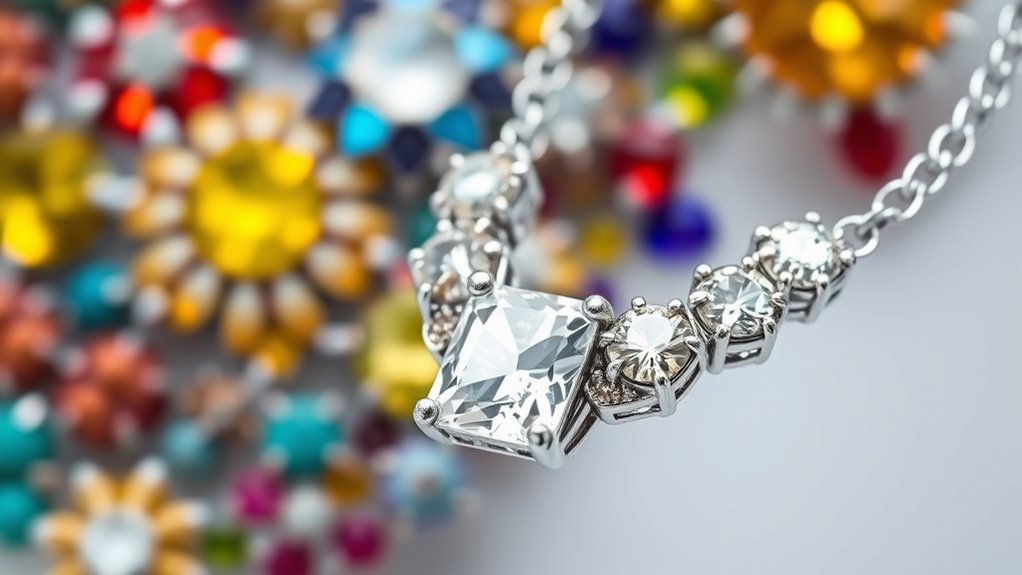
The craftsmanship behind high jewelry is a meticulous art that transforms precious materials into breathtaking masterpieces. You’ll see that gemstone sourcing plays a vital role, as master jewelers select stones with care, prioritizing ethical sourcing to guarantee responsible practices. This commitment to ethical sourcing means you’re getting more than just beauty; you’re supporting sustainable and fair trade practices. Every gemstone is carefully evaluated for quality, cut, and color, which influences the final piece’s elegance. Artisans spend countless hours handcrafting every detail, from setting stones precisely to polishing surfaces to perfection. Incorporating responsible sourcing into the process highlights the importance of ethical practices in high jewelry. This dedication results in jewelry that isn’t just visually stunning but also ethically crafted, reflecting a deep respect for both artistry and ethical sourcing. Additionally, the mastery involved in artistic craftsmanship ensures each piece is unique and holds intrinsic value beyond its appearance. Recognizing the quality control measures involved further guarantees that each masterpiece meets rigorous standards and showcases exceptional craftsmanship. Furthermore, the use of innovative techniques and traditional methods together elevates the overall craftsmanship quality, ensuring each high jewelry piece is a true work of art.
Material Quality and Rarity of Diamonds
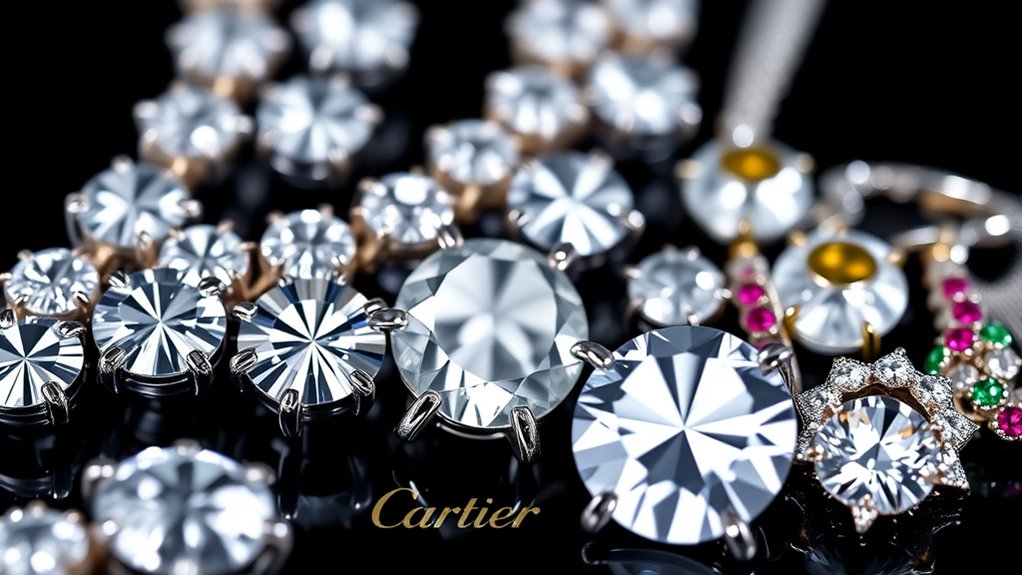
When evaluating high-quality diamonds, you’ll notice that their material quality and rarity substantially impact their value and appeal. Gemstone rarity plays a key role; rare diamonds are highly sought after and command higher prices. The most valuable stones often have exceptional qualities like perfect clarity, color, and cut, making them unique. Additionally, ethical sourcing is essential—buyers today prioritize diamonds that are responsibly mined, ensuring no conflict or exploitation. This ethical aspect can influence a diamond’s rarity, as responsibly sourced stones may be less common due to stricter regulations and sustainable practices. The combination of gemstone rarity and ethical sourcing elevates the desirability and price of Cartier’s diamonds, reflecting their superior material quality and the careful standards behind their procurement. Moreover, the grading process ensures each diamond meets stringent quality criteria, further distinguishing high-end pieces. Incorporating sustainable practices in sourcing also enhances the exclusivity and value of the diamonds, as ethical sourcing involves rigorous standards that contribute to their rarity and appeal, including transparent supply chains that verify origin and ethical standards. Additionally, certification and appraisal play a crucial role in validating the quality and authenticity of each diamond, reinforcing their desirability among discerning buyers.
The Artistic Design and Innovation

You immediately notice how high jewelry features creative design masterpieces that push artistic boundaries, unlike typical fashion pieces. The technical craftsmanship precision in high jewelry guarantees each piece is flawlessly executed, showcasing exceptional skill. Artistic innovation is seamlessly integrated, blending tradition with modernity to produce stunning, one-of-a-kind creations. Additionally, the artistic design often involves collaboration with renowned artists and designers, elevating each piece to a true work of art. The unique materials used in high jewelry, such as rare gemstones and precious metals, further distinguish these masterpieces from mass-produced fashion jewelry. These pieces also often incorporate international influences, reflecting a global appreciation for diverse artistic expressions. Moreover, the use of precious gemstones enhances the exclusivity and value of high jewelry pieces, setting them apart from more common fashion jewelry. The meticulous selection of materials and innovative techniques also contribute to the luxury appeal that defines high jewelry.
Creative Design Masterpieces
Creative design is the heart of jewelry innovation, where artisans push boundaries to craft breathtaking masterpieces. You’ll notice how gemstone symbolism plays a pivotal role, with each stone representing deeper meanings like love, power, or spirituality. Cultural influences inspire unique motifs and styles, blending tradition with modern artistry. High jewelry maisons like Cartier excel at transforming these elements into unforgettable designs that tell stories and evoke emotion. These creative masterpieces often feature bold concepts, innovative settings, and intricate details, elevating jewelry beyond simple adornments. Every piece reflects meticulous artistry and a desire to push creative limits. Additionally, understanding retirement planning strategies can inspire designers to incorporate timeless themes and durable materials, ensuring their creations stand the test of time and continue to hold value. By merging symbolism and cultural influences, designers craft jewelry that is not only beautiful but also rich in meaning and cultural significance.
Technical Craftsmanship Precision
Technical craftsmanship in high and fashion jewelry hinges on meticulous precision and innovative techniques that bring complex designs to life. Every detail, from setting diamonds to shaping intricate motifs, demands exceptional skill. In high jewelry, this precision extends to luxury packaging and retail display, ensuring each piece is showcased flawlessly, emphasizing its exclusivity. Cartier’s mastery in craftsmanship results in seamless finishes and perfect symmetry, highlighting the artistry behind every creation. Additionally, the use of handcrafted textiles in presentation and display further elevates the perceived value and uniqueness of high jewelry pieces. Fashion jewelry, while less intricate, still relies on exacting standards to maintain durability and visual appeal. Both categories require rigorous attention to detail, but high jewelry’s technical excellence elevates it, making each piece not just beautiful but a testament to superior craftsmanship and innovation. This precision underpins the value and allure of luxury jewelry.
Artistic Innovation Integration
Artistic innovation breathes new life into both high and fashion jewelry by pushing the boundaries of design and craftsmanship. You’ll notice how designers experiment with synthetic materials to create unique textures and effects that traditional gemstones can’t achieve. This integration allows for more daring and imaginative pieces, blending art with jewelry. In high jewelry, innovation often focuses on bespoke artistry and rare techniques, while fashion jewelry leans toward mass production with creative twists. Maximizing design potential enables designers to develop more complex and expressive pieces that stand out in the jewelry world. This fusion of technology and artistry elevates jewelry from mere adornment to wearable art.
The Role of Brand Heritage and Prestige
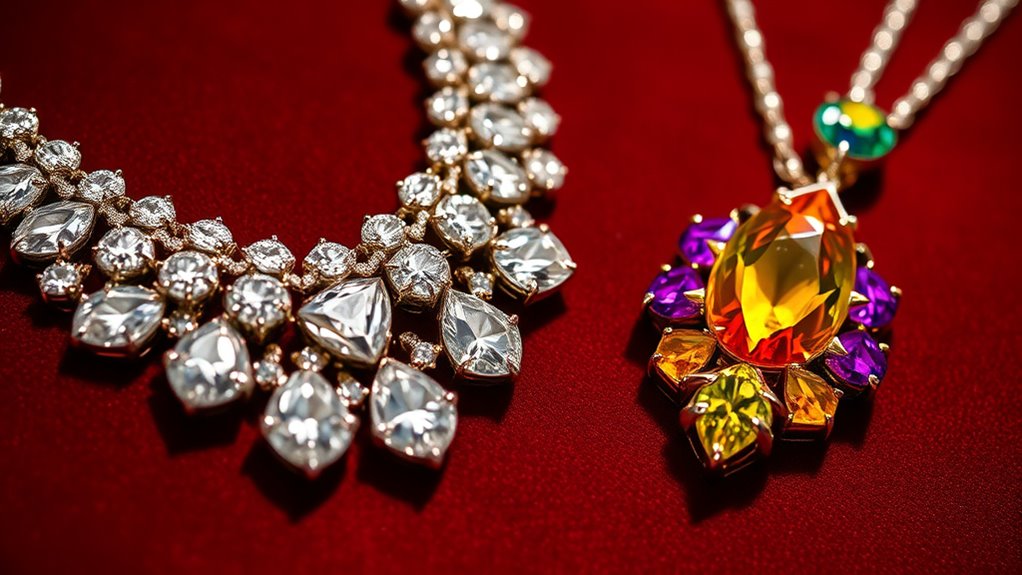
Your choice of jewelry often reflects the legacy and reputation of the brand behind it. Iconic brand recognition can elevate a piece from mere adornment to a symbol of prestige. Understanding how heritage influences value helps you appreciate the true significance of high jewelry versus fashion jewelry. For instance, the prestige associated with brands like Cartier often stems from their brand heritage, which contributes significantly to the higher cost of diamonds and fine jewelry.
Legacy and Reputation
How much does a brand’s heritage influence your perception of jewelry quality? Your view is often shaped by a brand’s legacy and market prestige. A storied history signals craftsmanship, exclusivity, and trust, making high-end pieces more desirable. Brands like Cartier have built their reputation over decades, solidifying their status as symbols of luxury. Their brand legacy isn’t just about history; it’s about the ongoing commitment to excellence. When you see a Cartier piece, you recognize the prestige that comes with decades of innovation and craftsmanship. This reputation justifies higher prices and adds emotional value. Additionally, the effectiveness of hydrocolloid patches demonstrates how reputation and perceived efficacy can influence consumer trust and willingness to pay premium prices. Recognizing the importance of brand heritage in luxury markets helps consumers understand why certain jewelry commands higher prices, as it encompasses trust, tradition, and a proven track record of quality. The legacy of craftsmanship plays a crucial role in reinforcing consumer confidence and perceived value. A strong brand reputation can also serve as a symbol of status, further elevating the desirability of high jewelry pieces. This reputation justifies higher prices and adds emotional value, especially when considering the potential impact of customer perception on luxury brand desirability.
Iconic Brand Recognition
Brand heritage and prestige considerably shape how you recognize and value jewelry. When you see a brand like Cartier, its luxury branding instantly signals exclusivity and quality. This brand prestige influences your perception, making high jewelry more desirable and worth the investment. Iconic brands build a legacy that reinforces their status and craftsmanship, setting them apart from lesser-known names. To better understand this, consider the table below:
| Brand | Heritage & Prestige | Signature Traits |
|---|---|---|
| Cartier | Over 170 years of luxury branding | Iconic designs, craftsmanship |
| Tiffany | Legendary American heritage | Signature blue box |
| Bulgari | Rich Roman legacy | Bold, colorful jewelry |
This recognition elevates high jewelry’s value, especially at brands like Cartier, where brand prestige justifies the higher cost. Additionally, the heritage & prestige of a brand often correlates with its reputation for quality and exclusivity.
Customization and Unique Pieces
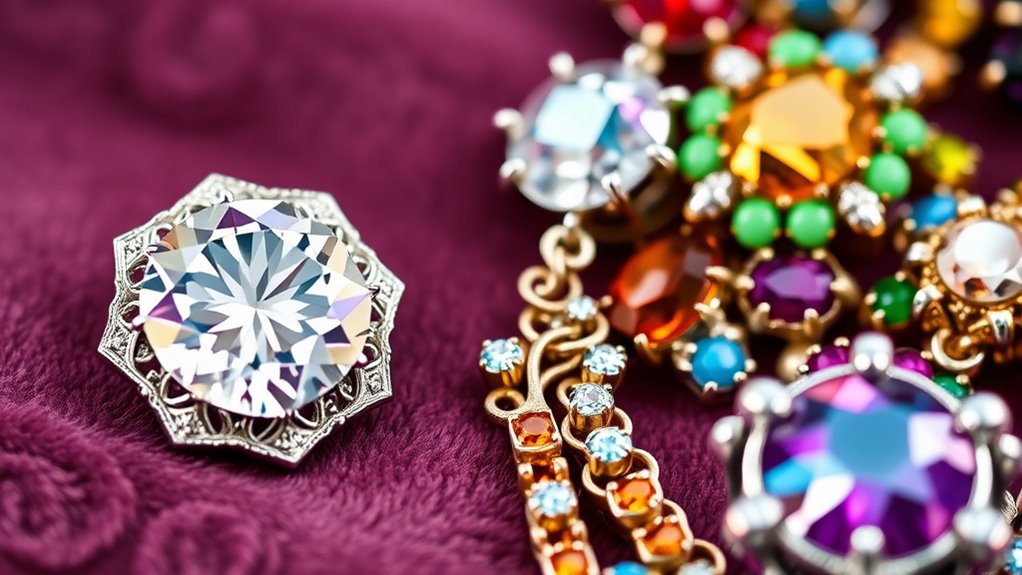
While mass-produced jewelry dominates the market, both high jewelry and fashion jewelry offer options for customization and one-of-a-kind pieces. You can explore personalized commissions that reflect your style and story, making each piece truly yours. High jewelry often provides exquisite one-of-a-kind creations crafted with meticulous artistry, ensuring exclusivity. Fashion jewelry, meanwhile, offers more accessible ways to customize with unique designs or limited editions. Here are some ways you can personalize your jewelry:
- Custom engravings
- Selective gemstone arrangements
- Unique metal finishes
- Bespoke design consultations
- One-of-a-kind creations tailored to your preferences
These options allow you to own jewelry that stands out, blending craftsmanship with your individuality. This level of personalization enhances the value and emotional connection to your jewelry collection.
The Impact of Limited Editions and Exclusivity
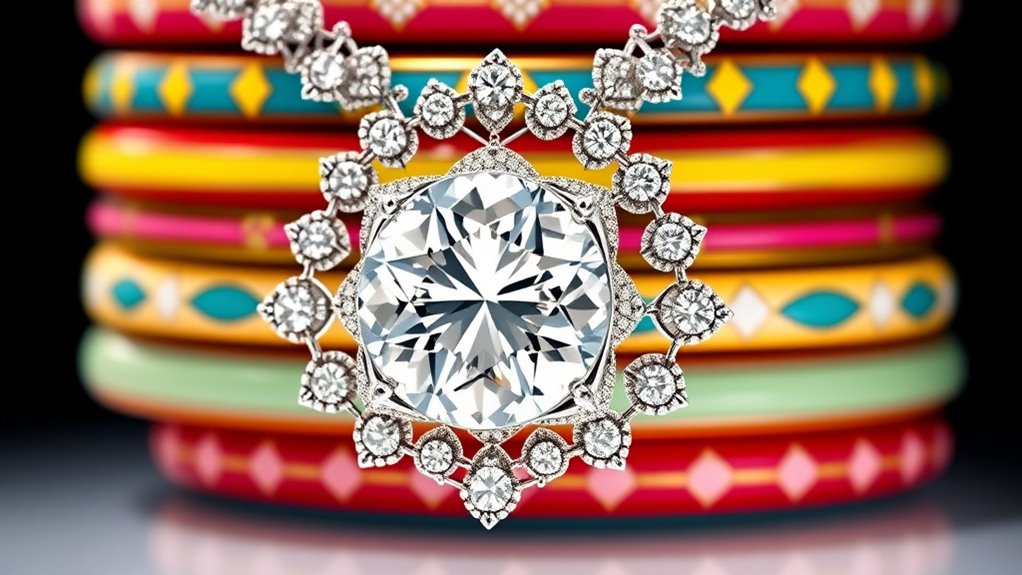
Limited editions and exclusivity profoundly influence the appeal of both high jewelry and fashion jewelry, creating a sense of rarity that enhances their desirability. When a piece is labeled as a limited edition, you know it’s unique, making it more coveted. Exclusivity factors, like limited production runs or special collaborations, boost the perceived value and desirability of jewelry. High jewelry brands, such as Cartier, often release limited editions to maintain their prestige and allure, attracting collectors and enthusiasts alike. Fashion jewelry, while more accessible, still leverages exclusivity factors to appeal to trendsetters seeking something distinctive. This sense of rarity makes the jewelry more desirable, often justifying higher prices in high jewelry and elevating the status of fashion pieces. Ultimately, limited editions and exclusivity substantially drive demand across both categories.
Investment Value and Long-Term Worth
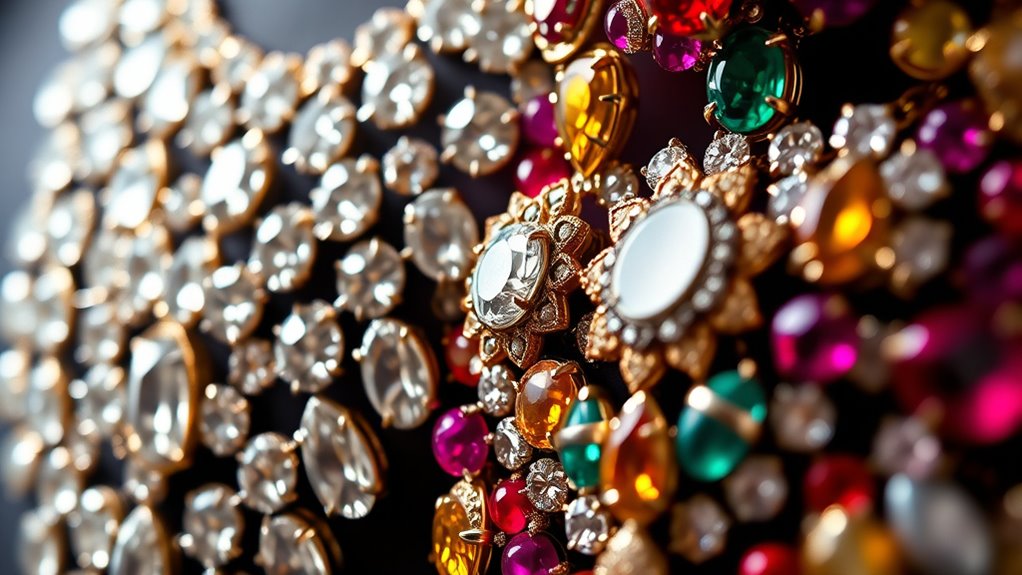
Exclusivity and rarity often boost a jewelry piece’s desirability, but when it comes to long-term value, the story is more nuanced. You need to contemplate how market fluctuations impact your investment and the resale value over time. High jewelry pieces, like Cartier diamonds, generally hold their worth better because of their enduring appeal and scarcity. Conversely, fashion jewelry can depreciate quickly and often doesn’t offer significant resale value. To assess long-term worth, keep these points in mind:
- Market fluctuations influence jewelry prices over time
- High jewelry tends to retain value better
- Resale value varies based on brand and rarity
- Investment-grade pieces often appreciate in worth
- Fashion jewelry usually depreciates faster
Understanding these factors helps you make smarter, more informed choices for your jewelry investments.
Differences in Production Processes

High jewelry and fashion jewelry differ markedly in their production processes, reflecting their distinct purposes and values. With high jewelry, gemstone sourcing is meticulous, often involving ethically sourced, rare stones that undergo strict quality checks. Manufacturing techniques are highly detailed, emphasizing craftsmanship and precision, with artisans spending hours on each piece. In contrast, fashion jewelry relies on mass production, using less expensive materials and simpler manufacturing techniques like casting or stamping. High jewelry’s complex processes involve hand-setting diamonds and intricate metalwork, ensuring exclusivity and superior quality. Fashion jewelry, on the other hand, prioritizes speed and affordability, producing larger quantities with streamlined methods. These fundamental differences in gemstone sourcing and manufacturing techniques directly influence both the quality and the overall value of each type of jewelry.
How Pricing Reflects Cultural and Market Factors
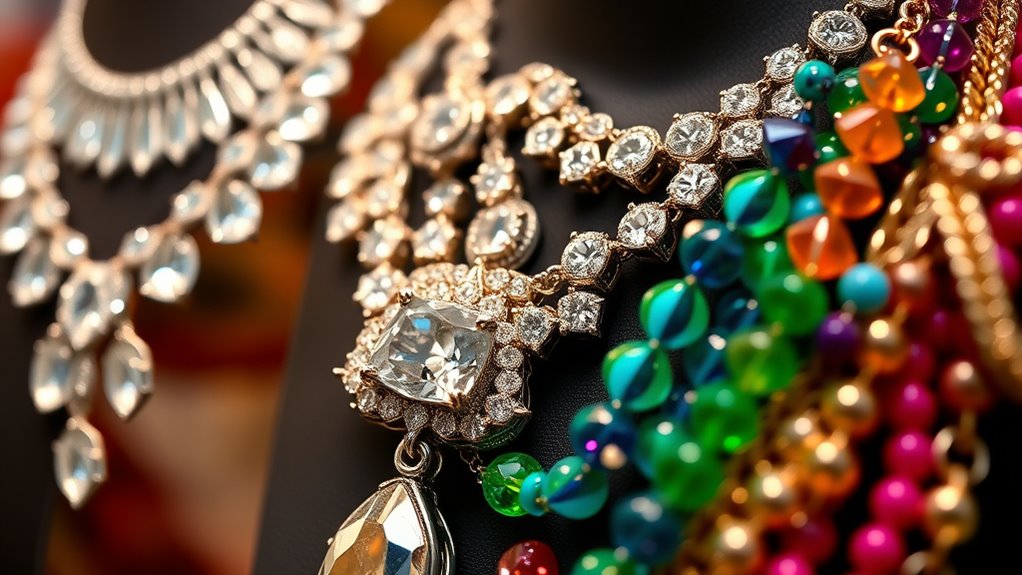
Pricing for jewelry often mirrors cultural values and market dynamics, shaping how each piece is valued and perceived. Cultural symbolism influences what people consider meaningful, driving demand for specific styles or stones. Market demand also plays a critical role; popular designs or rare materials command higher prices. You’ll notice that:
- Culturally significant symbols increase a piece’s value
- High demand for certain gemstones raises prices
- Traditions influence the perceived worth of jewelry
- Limited editions create exclusivity, boosting price
- Global trends impact market demand and pricing strategies
These factors show how cultural and market influences directly affect jewelry costs. Cartier’s high jewelry, for instance, often reflects deep cultural symbolism and rarity, justifying its premium price compared to mass-produced fashion jewelry.
Frequently Asked Questions
How Does Jewelry Resale Value Differ Between High Jewelry and Fashion Jewelry?
Your resale value for high jewelry typically remains higher than fashion jewelry because it’s considered a better investment with greater investment potential. High jewelry, like Cartier’s pieces, often retains or even appreciates in value due to rarity, craftsmanship, and brand prestige. In contrast, fashion jewelry usually depreciates quickly, making it less ideal for resale value. So, if you’re thinking long-term, high jewelry offers more financial security and investment potential.
What Environmental Impacts Are Associated With the Production of High Jewelry Versus Fashion Jewelry?
Think of jewelry production like planting a garden—high jewelry demands sustainable mining practices, reducing environmental harm, while fashion jewelry often uses eco-friendly packaging but less sustainable sources. High jewelry’s complex processes can create more environmental impact, but brands are now adopting eco-friendly techniques. For you, choosing high jewelry with sustainable practices supports responsible mining, minimizing environmental damage, unlike fast fashion jewelry, which may prioritize cost over environmental care.
How Do Ethical Sourcing Practices Influence Pricing in Luxury Diamond Jewelry?
Ethical sourcing and supply chain transparency substantially influence the price of luxury diamond jewelry. When you prioritize ethically sourced diamonds, companies often incur higher costs due to responsible mining practices and fair labor conditions. These costs are reflected in the final price, ensuring accountability and sustainability. By supporting transparent supply chains, you’re also investing in ethically produced jewelry, which often carries a premium but aligns with your values of social and environmental responsibility.
Are There Specific Certifications That Distinguish High Jewelry Diamonds From Fashion Jewelry?
You’ll find that high jewelry diamonds are distinguished by specific certifications that meet strict certification standards and grading criteria. These include prestigious labels like GIA, HRD, and IGI, which verify diamond quality, origin, and ethical sourcing. Such certifications confirm the diamonds’ authenticity, rarity, and superior craftsmanship, justifying their higher prices. Unlike fashion jewelry, high jewelry pieces often carry detailed certification documentation, emphasizing their exclusivity and the meticulous grading criteria they meet.
How Does Customer Service and After-Sales Support Vary Between Luxury and Fashion Jewelry Brands?
You’ll notice that luxury brands like Cartier offer superior customer care and all-encompassing warranty policies, unlike fashion jewelry brands. Their after-sales support is personalized, ensuring repairs, cleanings, and replacements are seamless. In contrast, fashion brands may provide limited assistance or warranties. This difference reflects their commitment to long-term client relationships and the value they place on quality, making your investment in high jewelry feel truly special and secure.
Conclusion
Think of high jewelry like a rare gemstone carved by time itself—you’re investing in a masterpiece that shines with history, craftsmanship, and exclusivity. While fashion jewelry sparkles brightly, high jewelry’s value is built on a foundation of artistry, rarity, and prestige that elevates it beyond mere adornment. When you choose Cartier’s diamonds, you’re not just buying jewelry; you’re owning a piece of art that holds its worth like a timeless treasure chest.









